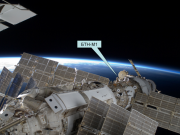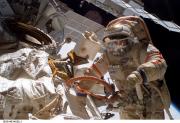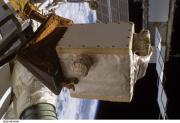BTN-Neutron (1-2) is a nuclear physics experiment aboard the Russian Segment of the International Space Station to measure the neutron component of the radiation background in the near-Earth space, spatial and temporal distribution of neutron fluxes and spectra, during solar flares in particular.
The experiment is carried out in several stages. For it, neutron spectrometers capable of registering neutron fluxes in a wide energy range (0.4 eV–15 MeV) and gamma radiation (60 keV–10 MeV) have been and will be delivered to the ISS.
The BTN-Neutron and BTN-Neutron-2 experiments are part of the Long Term Program of Scientific and Applied Research and Experiments planned on the Russian segment of the International Space Station (within the direction 'Earth and Space Studies').
Scientific Goals
- to develop a physical model of neutron albedo of Earth's atmosphere taking into account the effects of longitude and latitude of the measuring point, time of day and light conditions, atmospheric status;
- to create a physical model of neutron background in the ISS vicinity under different flight conditions;
- to build a physical model of charged and neutral particles generation during solar flares;
- to register in one and the same time solar protons and products of their interaction with the atmospheres of Earth and Mars together with the HEND neutron detector operating in Mars orbit under the Mars Odyssey program;
- to detect cosmic gamma-ray bursts simultaneous with similar instruments in Earth and Mars orbits, which gives an opportunity to determine the direction to the burst source with greater precision, and to observe their afterglows;
- to study radiation resistance of next-generation scintillators, which are placed inside the instrument electronics unit and then returned back to the Earth.
Mission Overview
Neutrons in the near-Earth space are born in interactions of galactic and solar cosmic rays (GCR and SCR) with the Earth's upper atmosphere, as a result of reactions of cosmic rays and radiation belts particles with the ISS structural elements, and also in powerful solar flares. Registration of neutrons in the ISS orbit will shed new light on the correlation between the neutron flux and the geographical coordinates and altitude of the station's orbit, the state of Earth's magnetosphere and atmosphere, and solar activity.
BTN-M1 scientific instrument hardware
- BTN-MD detection unit with four independent neutron detectors: three 3He proportional counters and one high-energy neutron detector based on stilbene crystal
- BTN-ME Electronics Unit
- Set of connecting cables for hardware units inside and outside the ISS
- Bracket to place the detector unit on the external surface of Zvezda Service Module.
Equipment for BTH-M1 experiment was delivered to the ISS in October 2006 aboard Progress Space Vehicle 358, installed and connected in November 2006 — February 2007 by the crew of 14th Expedition: Russian cosmonaut Mikhail Tyurin and US astronaut Michael Lopez-Alegria. The BTN-MD unit is placed outside the station, the BTN-ME — inside the station. Since February 26, 2007, the BTN-M1 equipment has been in regular operation on the ISS.
BTN-M1 is the second flight unit of the HEND neutron spectrometer, modified in accordance with the ISS equipment requirements and placed inside a special truss BTN-MF.
BTN-M2 scientific instrument hardware
- Neutron detectors unit consisting of 3He proportional counters with moderators of different thicknesses:
- thermal neutron detector (DTN);
- epithermal neutron detector (DEN);
- resonant neutron detector (DRN);
- stilbene-based scintillation detector (DBN), with organic scintillator particle shielding to detect fast neutrons.
- Scintillation detector (DG) based on LaBr3 crystal to register gamma rays.
The BTN-M2 equipment shall be installed inside the pressurized volume of the station.
Leading Organizations and Principal Investigators
- S.P. Korolev Rocket and Space Corporation (RSC Energia)
- Space Research Institute of the Russian Academy of Sciences (IKI)
- Principal Investigator of the experiment: Dr. Igor G. Mitrofanov
In Collaboration With
- Joint Institute for Nuclear Research (JINR)
- Research Institute of Atomic Reactors (RIAR)
- Skobeltsyn Institute of Nuclear Physics, Lomonosov Moscow State University (SINP MSU)
- All-Russian Scientific-Research Institute of Mineral Resources named after N.M. Fedorovsky (VIMS), Ministry of Natural Resources and Environment of the Russian Federation
- Blagonravov Mechanical Engineering Research Institute of the Russian Academy of Sciences (IMASH)
- State Research Center Institute of Biomedical Problems of the Russian Academy of Sciences (IBMP)
- Central Scientific Research Institute of Technologies and Machine-Building (CNIITMASH)
- Gagarin Research and Test Cosmonaut Training Center (GCTC)
Websites
- BTN-M1 page on the website of IKI Nuclear Planetology Department
- BTN-M2 page on the site of IKI Nuclear Planetology Department
- BTN-Neutron and BTN-Neutron-2 (in Russian) experiments on the website of The Scientific & Technical Advisory Council (STAC) on Scientific & Applied Research and Experiments onboard Manned Space Complexes
Gallery
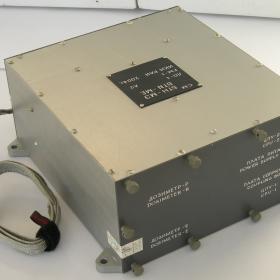

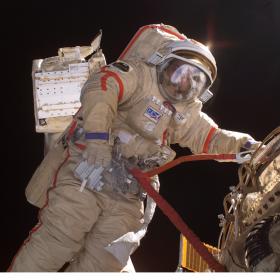
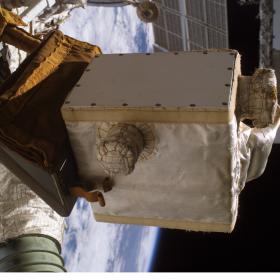
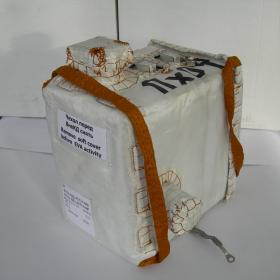
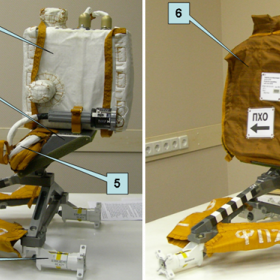

BTN-M1
Status: in operation as part of the ISS
Launch: 23.10.2006, 16:40 Moscow time, Baikonur, Progress M-58, Soyuz-U launch vehicle
Leading space agency: ROSCOSMOS
BTN-M2
Status: in operation as part of the Russian Segment of the ISS since 03.12.2024
Launch: 21.11.2024, 15:22 Moscow time, Baikonur, Progress MS-29, Soyuz-2.1a launch vehicle
Leading space agency: ROSCOSMOS
Main website: BTN-Neutron-2 space experiment onboard Russian Orbital Segment of International Space Station

